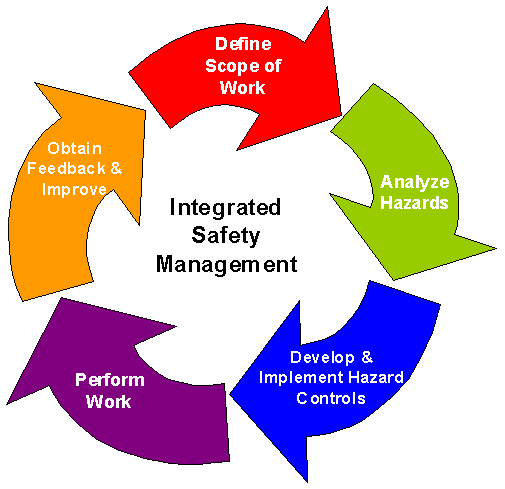|
|
How to plan for SAFETY in your job?
In an effort to provide a formal and organized process to manage all aspects of
Environment, Safety and Health (ES&H) issues at its laboratories, the DOE developed
the Integrated Safety Management System (ISMS). In short, it's a process that
allows people (such as staff and collaborators) at all levels to plan, perform, assess
and improve their implementation of ES&H at work. The system puts the
responsibility for safety on each individual.
Fundamental to the process are the Guiding Principles that can be viewed
as "best management practices", which are the
policies that integrate ISMS at all levels; the Core Functions, which
provide the day-to-day tools used to translate policies into something
we can all understand. And there is the Work Smart Standards Set, that provides
the laws and regulations that we have to work within at SLAC.
As many injuries and illnesses come about because of poor work planning,
the core function framework can be applied to all tasks. From the simple
and potentially hazardous, such as using a Skillsaw to cut a piece of wood,
to the complex and potentially hazardous, such as operating heavy equipment
or running a complicated experiment. SLAC has adopted the ISMS process and
promotes its values at all working levels.

A list of Guiding Principles and Core Functions follows:
Guiding Principles:
- Everyone (employee, user, subcontractor) is responsible and accountable
for the safe conduct of their own activities.
- There are clear roles and lines of responsibility, authority and
accountability at all levels of the organization. Everyone has the
right to tell someone to stop a potentially dangerous or environmental
threatening activity.
- Everyone in the workforce has the experience, knowledge, skills and
abilities to perform their work safely and competently.
- Management allocates resources (money, time, effort) to ensure work
can be performed safely.
- Hazards shall be evaluated and appropriately controlled before work
is performed to provide adequate protection to employees, the public and
the environment.
- Engineered or administrative controls shall be in place to mitigate
to acceptable levels work associated hazards.
- No work will be performed unless it can be done safely.
Core Functions:
- Define the Scope of Work - What is the job?
Supervisors/Managers/Responsible Persons define what work needs to be
done to achieve the mission of the lab. Within this they set expectations,
prioritize tasks and allocate resources.
- Analyze the Hazard - What safety hazards are present or possible?
During this step the hazards associated with a particular job, task or
project are identified and analyzed to determine regulatory and compliance
needs.
- Develop and Implement Hazard Controls - How can this job be performed
safely?
After identifying the standards or regulations pertaining to a hazard or
category of hazards, solutions are proposed to minimize risks, allowing
for a safe and healthful work place. Implementation of the safety controls
that mitigate or reduce hazards to acceptable levels are employed and the
safety envelope is established.
- Perform Work within Controls - Don't take chances, cut corners or rush
to finish a job.
Confirm the readiness of the safety controls to do their job (such as
shielding for radiation, or providing eye protection in a machine shop)
and perform the work safely.
- Provide for Feedback and Continuous Improvement - Make a note if the
job could have been done in a better way or more safely, and make the
change happen.
As within any system, feedback (meetings with supervisors, staff meetings,
lessons learned programs, etc.) is a necessity to understand what works
and what doesn't, This process allows for real time intervention and
provides assurance the safety system operates to expectations.
Work Smart Standards Set
What ES&H regulations are out there to help me get my work done
safely and within the boundaries of the law, and if I don't know, where
can I go for help?
The laws and regulations that specify the ES&H requirements for the
laboratory have been identified through a site analysis of potential
hazards, and are contained in the SLAC Work Smart Standards (WSS) set.
These requirements are extensive. While it is not necessary that everyone
know the details of these laws and regulations, it is necessary that
workers know about the hazards of their job or task and that managers
and supervisors, know how and where to obtain help in defining which
part of the WSS applies to their activities (such as from their the
Divisional ES&H Coordinator or the, ES&H Division).
|

